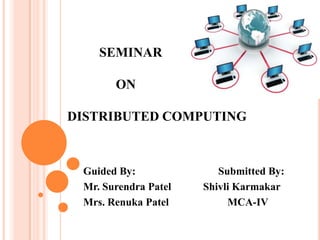
Distributed computing
- 1. SEMINAR ON DISTRIBUTED COMPUTING Guided By: Submitted By: Mr. Surendra Patel Shivli Karmakar Mrs. Renuka Patel MCA-IV
- 2. CONTENTS:- Overview History Introduction Working of Distributed system Types Motivation goals characteristics architecture example Advantages Disadvantages Conclusion Reference
- 3. OVERVIEW DISTRIBUTED COMPUTING A distributed system is one in which hardware or software components located at networked computers communicate and coordinate their actions only by message passing. In the term distributed computing, the word distributed means spread out across space. Thus, distributed computing is an activity performed on a distributed system. These networked computers may be in the same room, same campus, same country, or in different country.
- 4. HISTORY The use of concurrent processes that communicate by message-passing has its roots in operating system architectures studied in the 1960s. The study of distributed computing became its own branch of computer science in the late 1970s and early 1980s. The first conference in the field, Symposium on Principles of Distributed Computing (PODC), dates back to 1982, and its European counterpart International Symposium on Distributed Computing (DISC) was first held in 1985.
- 5. INTRODUCTION In distributed system each processor have its own memory. The computational entities are called computers or nodes. In distributed computing a program is split up into parts that run simultaneously on multiple computers communicating over a network. Distributed computing is a form of parallel computing.
- 6. WORKING OF DISTRIBUTED SYSTEM: Fig. A Distributed System
- 7. TYPES OF DISTRIBUTED COMPUTING: Grid computing Multiple independent computing clusters which act like a “grid” because they are composed of resource nodes not located within a single administrative domain. (formal) The creation of a “virtual supercomputer” by using spare computing resources within an organization. Cloud computing Cloud computing is a computing paradigm shift where computing is moved away from personal computers or an individual application server to a “cloud” of computers. Users of the cloud only need to be concerned with the computing service being asked for, as the underlying details of how it is achieved are hidden. This method of distributed computing is done through pooling all computer resources together and being managed by software rather than a human.
- 8. MOTIVATION The main motivations in moving to a distributed system are the following: Inherently distributed applications. Performance/cost. Resource sharing. Flexibility and extensibility. Availability and fault tolerance. Scalability.
- 9. GOALS Making Resources Accessible The main goal of a distributed system is to make it easy for the users (and applications) to access remote resources, and to share them in a controlled and efficient way. Distribution Transparency An important goal of a distributed system is to hide the fact that its processes and resources are physically distributed across multiple computers. Openness An open distributed system is a system that offers services according to standard rules that describe the syntax and semantics of those services. scalability Scalability of a system can be measured along at least three different dimensions.
- 10. CHARACTERISTICS Resource Sharing:- Resource sharing is the ability to use any hardware, software or data anywhere in the system. Openness:- Openness is concerned with extensions and improvements of distributed systems. Concurrency:- Concurrency arises naturally in distributed systems from the separate activities of users, the independence of resources and the location of server processes in separate computers. Scalability:- Scalability concerns the ease of the increasing the scale of the system (e.g. the number of processor) so as to accommodate more users and/or to improve the corresponding responsiveness of the system. Fault tolerance:- Fault tolerance cares the reliability of the system so that in case of failure of hardware, software or network, the system continues to operate properly, without significantly degrading the performance of the system. Transparency:- Transparency hides the complexity of the distributed systems to the users and application programmers.
- 11. ARCHITECTURE
- 12. EXAMPLES OF DISTRIBUTED SYSTEMS Examples of distributed systems and applications of distributed computing include the following: Telecommunication networks: Telephone networks and cellular networks Computer networks such as the Internet Network applications: World wide web and peer-to-peer networks Massively multiplayer online games and virtual reality communities Real-time process control: Aircraft control systems Industrial control systems Parallel computation: Scientific computing, including cluster computing and grid computing and various volunteer computing projects Distributed rendering in computer graphics
- 13. ADVANTAGES Economics Speed Inherent distribution of applications Reliability Extensibility and Incremental Growth Distributed custodianship Data integration Missed opportunities
- 14. DISADVANTAGES Complexity Network problem Security
- 15. CONCLUSION In this age of optimization everybody is trying to get optimized output from their limited resources. The concept of distributed computing is the most efficient way to achieve the optimization. In case of distributed computing the actual task is modularized and is distributed among various computer system. It not only increases the efficiency of the task but also reduce the total time required to complete the task.
- 16. REFERENCES Distributed Computing. http://distributedcomputing.info/index.html Jie Wu, Distributed System Design, CRC Press, 1999. Distributed Computing, Wikipedia http://en.wikipedia.org/wiki/Distributed_computing http://www.mu.ac.in/myweb_test/MCA%20study%20materi al/M.C.A.(Sem%20- %20V)%20Distributed%20Computing.pdf What is distributed computing? - Definition from WhatIs.com http://arxiv.org/ftp/arxiv/papers/0911/0911.4395.pdf